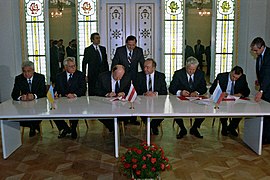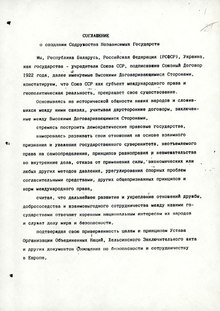Belovezha Accords
This article needs additional citations for verification. (April 2008) |
 The signing ceremony at Viskuli Government House | |
| Type | Treaty establishing a loose regional organisation |
|---|---|
| Signed | December 8, 1991 |
| Location | Viskuli, Belovezh Forest, Belarus (de facto) Minsk, Minsk Oblast, Belarus (de jure) |
| Effective |
|
| Signatories |
|
| Parties |
|
| Depositary | |
| Languages | Belarusian, Russian, Ukrainian |
The Belovezha Accords (Russian: Беловежские соглашения, Belarusian: Белавежскае пагадненне, Ukrainian: Біловезькі угоди) are accords forming the agreement that declared the Union of Soviet Socialist Republics (USSR) as effectively ceasing to exist and established the Commonwealth of Independent States (CIS) in its place as a successor entity. The documentation was signed at the state dacha near Viskuli in Belovezhskaya Pushcha (Belarus) on December 8, 1991, by leaders of three of the four republics which had signed the 1922 Treaty on the Creation of the USSR:
- Russian President Boris Yeltsin and First Deputy Prime Minister of the RSFSR/Russian Federation Gennady Burbulis
- Ukrainian President Leonid Kravchuk and Ukrainian Prime Minister Vitold Fokin
- Belarusian Parliament Chairman Stanislav Shushkevich and Prime Minister of Belarus Vyacheslav Kebich
The original document could not be found as of 2013 (see below).
Name[]
The name is variously translated as Belavezh Accords, Belovezh Accords, Belovezha Accords, Belavezha Agreement, Belovezhskaya Accord, Belaya Vezha Accord, etc.
Legal basis and ratification[]
While doubts remained over the authority of the leaders of three of the 12 remaining republics (the three Baltic republics had seceded in August) to dissolve the Union, according to Article 72 of the 1977 Soviet Constitution, union republics had the right to secede freely from the Union (the procedure for the withdrawal of the republics from the Union since 1990 was regulated by a special law[1]). On December 12, 1991, the Supreme Soviet of the Russian SFSR ratified the accords on behalf of Russia and at the same time denounced the 1922 Treaty on the Creation of the Soviet Union.

The preamble of the document stated that "the USSR, as a subject of international law and a geopolitical reality, is ceasing its existence". It also invited other republics to join the three founding members.
On December 12, the Supreme Soviet of the Russian SFSR formally ratified the Belovezha Accords,[2] denounced the 1922 Union Treaty, and recalled the Russian deputies from the Supreme Soviet of the USSR. The legality of this ratification raised doubts among some members of the Russian parliament, since according to the Constitution of the RSFSR of 1978 consideration of this document was in the exclusive jurisdiction of the Congress of People's Deputies of the RSFSR.[3][4][5][6]
These attempts to dissolve the Soviet Union were seen as illegal by what remained of the Soviet federal government. Gorbachev himself described the moves thus:
The fate of the multinational state cannot be determined by the will of the leaders of three republics. The question should be decided only by constitutional means with the participation of all sovereign states and taking into account the will of all their citizens. The statement that Unionwide legal norms would cease to be in effect is also illegal and dangerous; it can only worsen the chaos and anarchy in society. The hastiness with which the document appeared is also of serious concern. It was not discussed by the populations nor by the Supreme Soviets of the republics in whose name it was signed. Even worse, it appeared at the moment when the draft treaty for a Union of Sovereign States, drafted by the USSR State Council, was being discussed by the parliaments of the republics.[7]
There was some question as to whether the Belovezha Accords were enough in and of themselves to dissolve the Soviet Union since they were signed by only three republics, albeit three of the five largest and most powerful republics. However, all doubts about whether the Soviet Union still existed were removed on December 21, 1991, when the representatives of 11 of the 12 remaining Soviet republics—all except Georgia—signed the Alma-Ata Protocol, which confirmed the extinction of the Soviet Union and restated the establishment of the CIS. Given that 11 of the republics now agreed that the Soviet Union no longer existed, the plurality of member-republics required for its continuance as a federal state was no longer in place. The summit of Alma-Ata also provisionally accepted Gorbachev's resignation as president of the Soviet Union and agreed on several other practical measures consequential to the extinction of the Union. Gorbachev stated that he would resign as soon as he knew the CIS was a reality. Three days later, in a secret meeting with Yeltsin, he accepted the fait accompli of the Soviet Union's dissolution.
However, for four more days a rump Soviet federal government continued to exist, and Gorbachev continued to hold control over the Kremlin. This ended in the early hours of December 25, 1991, when Gorbachev resigned and turned control of the Kremlin and the remaining powers of his office over to the office of the president of Russia, Yeltsin.
Gorbachev's televised resignation speech and the subsequent lowering of the flag of the Soviet Union and hoisting of the flag of Russia on the flagpole in front of the Kremlin was broadcast around the world. On this day, President of the United States George H. W. Bush, a former head of the CIA, gave a short speech on national TV in the United States to commemorate the ending of the Cold War and to recognize the independence of the former states of the Soviet Union.[8]
Also on December 25, 1991, the Russian SFSR, now no longer a sub-national entity of the Soviet Union but a sovereign nation in its own right, adopted a law renaming itself the "Russian Federation" or "Russia" (both being equally official with the ratification of the Russian constitution in 1993).
Gorbachev's speech and the lowering of the Soviet flag marked the end of the Soviet Union in the eyes of the world. However, the final legal step in the dissolution came a day later, when the Soviet of the Republics, the upper house of the Supreme Soviet of the USSR, recognized the collapse of the Union and voted both itself and the Union out of existence. The lower house, the Soviet of the Union, had not met since December 12 when Russia recalled its deputies from both chambers, leaving it without a quorum.[citation needed]
The Summit of Alma-Ata also issued a statement on December 21, 1991, supporting Russia's claim to be recognized as the successor state of the Soviet Union for the purposes of membership of the United Nations. On December 25, 1991, Russian President Yeltsin informed UN Secretary-General Javier Pérez de Cuéllar that the Soviet Union had been dissolved and that Russia would, as its successor state, continue the Soviet Union's membership in the United Nations. The document confirmed the credentials of the representatives of the Soviet Union as representatives of Russia and requested that the name "Soviet Union" be changed to "Russian Federation" in all records and entries. This was a move designed to allow Russia to retain the Soviet Union's permanent Security Council seat, which would not have been possible if the former republics were all reckoned as equal successors of the Soviet Union, or if the Soviet Union was regarded as having no successor state for the purpose of continuing the same UN membership (see Russia and the United Nations). The Secretary-General circulated the request, and there being no objection from any Member State, the Russian Federation took the Soviet Union's UN seat. On January 31, 1992, Russian Federation President Yeltsin personally took part in a Security Council meeting as representative of Russia, the first Security Council meeting in which Russia occupied the permanent Security Council seat originally granted to the Soviet Union by the UN Charter.[citation needed]
Aftermath[]
Current location[]
Stanislav Shushkevich, the former leader of Belarus was told by the country's foreign ministry that the original accords have gone missing as of February 7, 2013. He tried to obtain the original copy to assist in writing his memoirs.[9]
See also[]
- Dissolution of the Soviet Union
- Union Treaty of 1922, which was denounced by the Belovezha Accords.
Notes[]
References[]
- ^ Закон СССР от 3 апреля 1990 года № 1409-I «О порядке решения вопросов, связанных с выходом союзной республики из состава СССР»
- ^ Постановление Верховного Совета РСФСР от 12 декабря 1991 года № 2014-I «О ратификации Соглашения о создании Содружества Независимых Государств»
- ^ V.Pribylovsky, Gr.Tochkin . Kto i kak uprazdnil SSSR
- ^ Из СССР В СНГ: подчиняясь реальности
- ^ Бабурин С. Н. На гибель Советского Союза
- ^ Воронин Ю. М. Беловежское предательство
- ^ Mikhail Sergeevich Gorbachev (2000). On my country and the world. Columbia University Press. ISBN 978-0-231-11514-8.
- ^ "Bush on the Commonwealth of Independent States". Encarta. Archived from the original on October 31, 2009.
- ^ "Document proclaiming death of Soviet Union missing". The Daily Telegraph. London. February 7, 2013.
External links[]
| Wikimedia Commons has media related to Belovezha Accords. |
- Soviet Leaders Recall ‘Inevitable’ Breakup Of Soviet Union, Radio Free Europe, 8 December 2006
- Facsimile and transcription (in Russian)
- 14 Years of Belavezha Accords’ Signing
- map location
- 1991 in Belarus
- 1991 in Russia
- 1991 in the Soviet Union
- 1991 in Ukraine
- Belarus–Russia relations
- Belarus–Ukraine relations
- Dissolution of the Soviet Union
- Russia–Ukraine relations
- Treaties concluded in 1991
- Treaties entered into force in 1991
- Treaties of Belarus
- Treaties of Russia
- Treaties of the Russian Soviet Federative Socialist Republic
- Treaties of the Soviet Union
- Treaties of Ukraine
- Boris Yeltsin
- December 1991 events in Europe
- 1990s in Minsk
- Events in Minsk
- History of diplomacy
